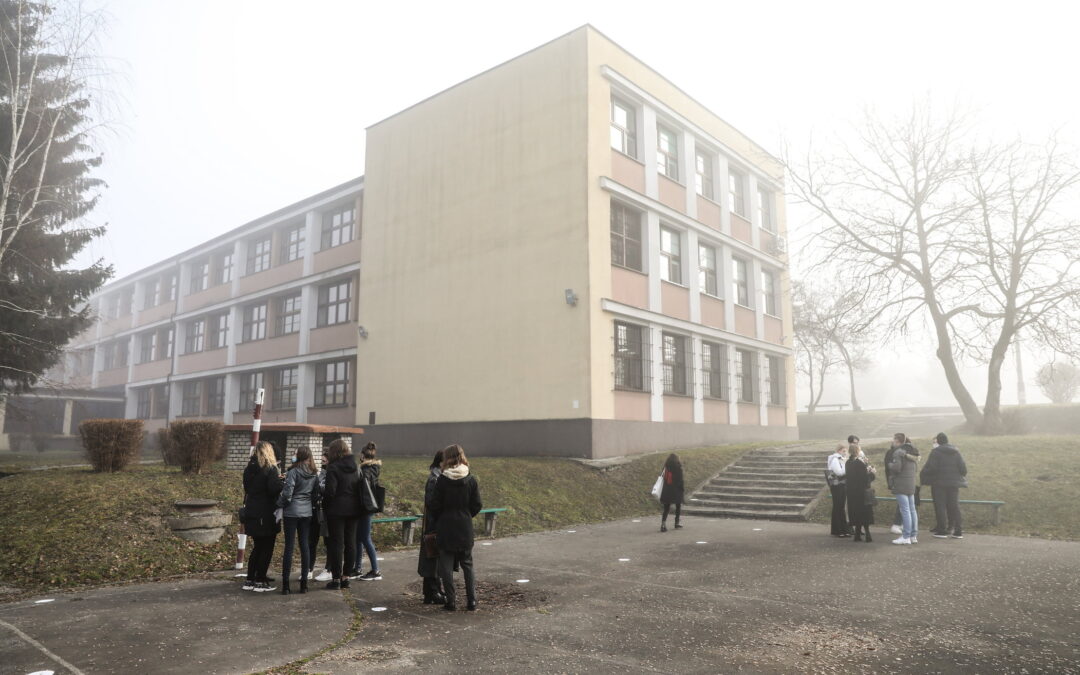By Arkadiusz Walczak
At the start of this month, almost 4.6 million pupils went back to school in Poland, facing a very difficult year. As children return to their desks after 18 months of mostly online teaching and adjust to spending long periods in the classroom with their schoolmates, many are struggling with psychological problems that have been exacerbated by the pandemic.
But these are not the only challenges the education system has to deal with. Providing suitable teaching staff represents an equally daunting task. This year, 12% of schools began the year without a full staff. In late August, Polish education boards listed more than 13,600 teaching job vacancies. At the same stage in 2020, there were only around 4,000.
In Warsaw alone, approximately 7% of teachers quit their jobs in the last school year. The number of vacancies in the capital has risen from 1,600 three years ago to more than 2,000 now, especially in early childhood education and among dayroom tutors, special needs specialists, and teachers of English, information technology and physics.
Many headteachers also left, including during the school year, which had previously been a rare occurrence. Warsaw is no exception here – all large cities are struggling with similar problems. And staff shortages in education have been getting worse for years.
According to a report by Poland’s Supreme Audit Office (NIK), a state body, between 1 January 2018 and 26 March 2021, lack of teachers was one of the biggest problems education in the country experienced. Almost half (46%) of headteachers complained about difficulties attracting teachers. The subjects in which teachers were hardest to come by were physics (mentioned by 33% of headteachers) and mathematics (32%), followed by chemistry (24%), English (20%) and IT (18%).
Low pay and ageing workforce
One of the main reasons for the reduced interest in teaching is low pay – teachers starting out in the profession earn around the minimum wage. The recent reform of the school system introduced by former education minister Anna Zalewska and abolition of middle schools (gimnazjum) also reduced the teaching workforce.
An effect of the reform was reduced confidence that working in a school is a guarantee of stable employment. As schools were closed or merged with others, teachers left. Faced with legal chaos and seeing their work belittled, many were reluctant to continue in the profession.
Without an injection of young blood, the Polish teaching community is ageing. In the 2017/2018 school year, the average age was 43.9 (43.7 for women and 45.2 for men); the following year, it was 44.1 (43.9 for women and 45.4 for men). This continues a trend that saw the average age increase by 3.5 years between 2007, when it was still under 40, and 2014.
The proportion of educational staff under 30 is just 8.2%, well below the EU average of 11.9%. In 2007 it was 14.2%.
The largest age gap is in secondary schools, where in the space of just four years, between 2013 and 2017, the percentage of the youngest age group of teachers fell from 9.1% to just 5.2%. In 2018/2019, more than half a million people were teaching in Polish schools. Of these, only 20% were teacher trainees and contract teachers (the next stage after traineeship). The most senior grade of teachers accounted for 55%, compared to 25% in 2005/2006.
Young graduates looking elsewhere
Rising inflation, falling real purchasing power, and fast-increasing living costs, particularly in big cities, are also causing many young people to leave teaching, while many other graduates of education studies and specialisations are not joining the profession at all.
Poland’s growing economy has also created other, better-paid job opportunities for graduates, making teaching less attractive. Teaching degrees have recorded the largest falls in enrolment, by around 60% within a decade. Furthermore, a Polish Agency for Enterprise Development report from 2012 showed that such courses were in third place in terms of graduate unemployment.
“The teachers’ strike laid bare the scale of the crisis in the sector,” said Adam Jagiełło-Rusiłowski of the University of Gdańsk’s pedagogy department, referring to strikes that took place in spring 2019.
Warsaw reports that 77% of schools are closed today, and the situation is similar around the country. It is the first such strike by teachers for over 25 years, and their unions vow they will remain off work indefinitely until their pay demands are met https://t.co/VGFzD8qtIX
— Notes from Poland 🇵🇱 (@notesfrompoland) April 8, 2019
“Our students on teaching practice see the frustration of their older colleagues and hear their criticism of the work. They see a lack of respect for the profession. This certainly does not encourage people to choose to work in a school,” he added. “So they get a job as an assistant in a shopping mall. They are also put off working in school by issues of the new curriculum and the general legal mess caused by the so-called reform.”
The abolition of middle schools following the 2017 reform also increased the number of people retiring, including those taking early retirement compensation. The teachers’ strike and the government’s reaction significantly deepened and reinforced frustrations in the profession.
Interestingly, data from Poland’s Social Insurance Institution (ZUS) show that the number of teachers taking retirement has decreased since the beginning of the pandemic. This can be explained by the fact that online teaching is in fact appealing to many older teachers, as not needing to go to school gave them a sense of relative safety.
Also significant has been the impact of persuasion by headteachers, who have often encouraged people reaching retirement age – and sometimes even receiving their pensions – to continue working at schools.
In response to teachers threatening to strike over low pay, the president's chief of staff says they should just have more children so they can supplement their salary with benefits.
'Teachers are not obliged to live in celibacy,' he says. https://t.co/CBc9tg2mV2
— Notes from Poland 🇵🇱 (@notesfrompoland) March 3, 2019
This has particularly been the case with vocational training, where teaching shortages and a low influx of new specialists have been felt particularly acutely. Such trainers in these sectors can earn much more in business and services, for example as construction specialists and in mechatronics engineering, not to mention IT.
Meanwhile, increasing numbers of teachers are taking a year-long leave of absence for health reasons – and ZUS is responding by stepping up checks.
But the Ministry of Science and Higher Education does not see a problem with teaching shortages, although these checks were its idea. The ministry says that natural staff movements are to blame, although it does not actually monitor fluctuation among teachers, which is essential for accurately evaluating the situation in schools.
Dealing with the problem
Headteachers are dealing with the problems of teaching vacancies in various ways. The most common and simplest solution seems to be allocating overtime hours to already employed teachers. On the one hand, this gives them the chance to increase their earnings. On the other, though, it significantly adds to their work burden, which often has a negative impact on teaching quality.
The aforementioned NIK report shows that over half of schools have given teachers extra hours. Some 76% of teachers say that they work overtime. More than one in ten teach in several schools.
Another solution is employing people without the appropriate qualifications. To do so, headteachers must gain the approval of the provincial education superintendent. This is happening frequently in the current situation.
Unfortunately, headteachers note that staff shortages force them to employ people who are not only unqualified, but also often lack the aptitude for working with children and teenagers, as well as to extend the contracts of others with qualifications but who are unsuited to working in schools.
One solution that is often put into place when there is no other option is so-called ad hoc substitute teaching, when classes are taken by any teacher who happens to be available at the time. The negative consequences this form of work can have for pupils need no explanation.
The main problem, however, is the lack of young teachers joining. This situation seems unlikely to change without systemic changes in terms of employment policy as well as teachers’ salaries. This is also related to the separate question of teacher training, meaning preparing staff for working in schools and offering teaching placements.
The actions of the ministry responsible for education in Poland in recent years have clearly led to an exodus of teachers from the profession. Numerous implemented and promised structural and programme changes, the poor quality of the education law, planned modifications to professional status, teaching load, form of employment, reduced autonomy for schools and ideologisation of education have all contributed to many teachers retiring and their younger colleagues seeking other lines of work.
Teachers rank high up on lists of the most trusted professions – in sixth place according to a Centre for Public Opinion Research report, after firefighters, nurses, qualified manual workers, miners and doctors.
As a society, then, we are well aware of the importance of this profession. It is a shame, however, that for years this understanding has not translated into genuine action to strengthen its prestige and demonstrate its importance for building a modern civil society.
Translated by Ben Koschalka
Main image credit: Wojciech Habdas / Agencja Gazeta





















